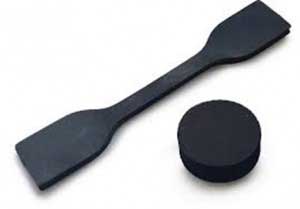Rubber is one such material which gets affected by environmental conditions. Although the tolerance is quite high but it is susceptible to change due to temperature, humidity, external forces, etc. Specifically, tension and compression play a crucial role in deciding the quality of rubber in accordance with the application. For instance, rubber tires have very high tensile strength, on the other hand, an eraser has low tensile strength because the application doesn’t demand so. The test methods used for measuring tensile strength are based on ASTM-4 and some other related standards.
You can use the tensile testing machine for performing the tests.
How to check the tensile strength of Rubber?
You cannot check the tensile strength manually, you need to have specified conditions as per standards and a machine that can exert an outward force on the rubber sample. Cut the sample into dumb-bell shape using cutting dye. Now clamp the sample into the jaws of the tensile testing machine. Depending upon the sample material, you have to choose the grip type. After starting the test, the movable plate will start to move up exerting the outward pressure on the sample. The machine will keep on moving in an upward direction until sample deforms or ruptures. As soon sample rupture, the machine will stop moving and the force required to break the sample will be displayed on the machine.
What other tests that can be conducted on the rubber to check properties?
The quality of rubber varies widely due to the percentage of ash content into it. To check the ash percentage, you just burn the sample in the muffle furnace and measure the left-over ash on the calibrated weight. The carbon contents will get turned into fumes and taken out. The weight of ash will be compared with the weight of the sample. The difference in weight is converted into ash percentage. The temperature of muffle furnace can be taken as high as 1200°C. The sample is burnt on the boat-shaped crucible bowl. The measurement is done along with the bowl, provided you know the weight of the bowl.
Another important test is abrasion test. In this test, an abrasion test is run against the sample. Due to continuous rubbing, the sample will lose some of its content. This loss can be measured by visual analysis or by weighing the sample before and after performing the test. This test is perfect for the footwear industry. It helps in calculating the shelf life of the sole when rubbing against the surface.
Another test that is important to perform is humidity test. this test can be done by using Humidity chamber. In this chamber, you can analyse the behaviour of the rubber sample in up to 95% humidity level.
